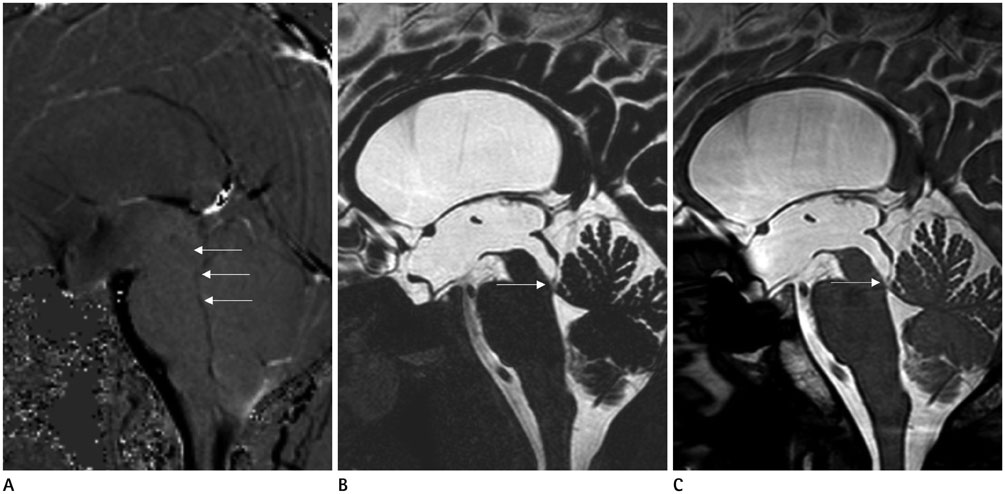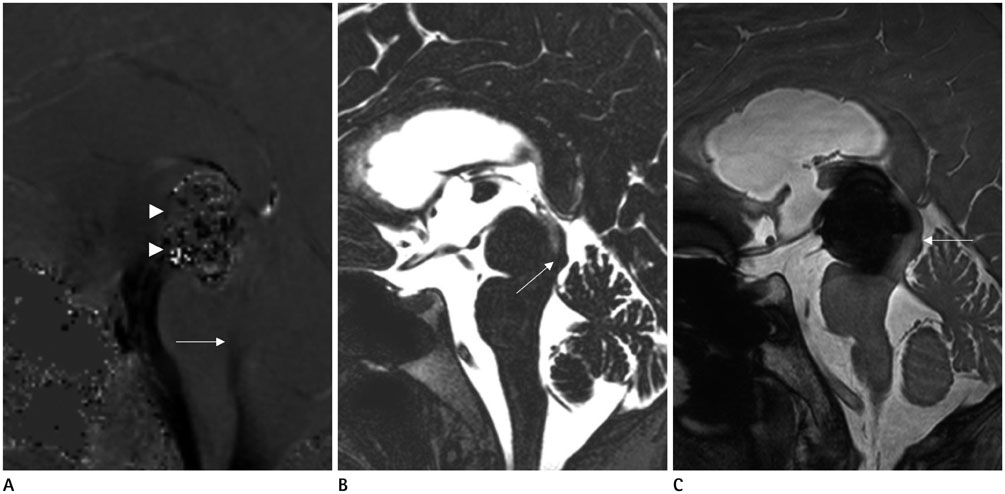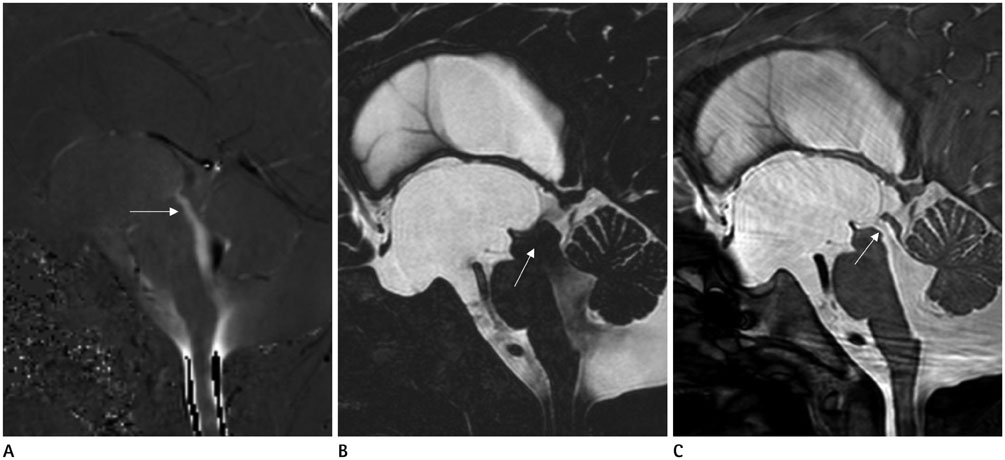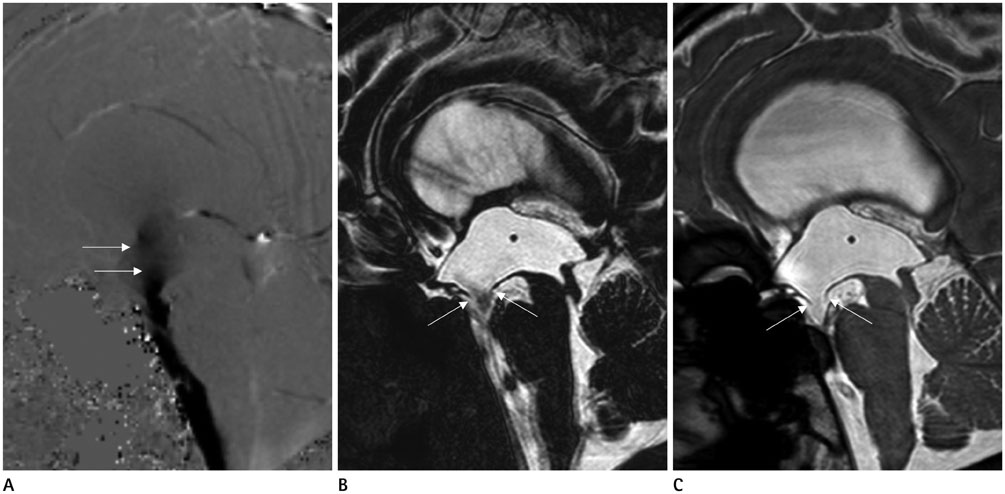J Korean Soc Radiol.
2015 Jul;73(1):26-35. 10.3348/jksr.2015.73.1.26.
Utility of Two Types of MR Cisternography for Patency Evaluation of Aqueduct and Third Ventriculostomy Site: Three Dimensional Sagittal Fast Spin Echo Sequence and Steady-State Coherent Fast Gradient Echo Sequence
- Affiliations
-
- 1Department of Radiology, Seoul National University College of Medicine, Seoul National University Bundang Hospital, Seongnam, Korea. xmida@hanmail.net
- 2Department of Radiology, Kyung Hee University College of Medicine, Kyung Hee University Hospital, Seoul, Korea.
- KMID: 1823919
- DOI: http://doi.org/10.3348/jksr.2015.73.1.26
Abstract
- PURPOSE
We aimed to evaluate the utility of two types of MR cisternography [fast spin echo sequence and steady-state coherent gradient echo (GRE) sequence] in addition to phase contrast-cine imaging (PC-cine), for assessing patency at the aqueduct and third ventriculostomy site.
MATERIALS AND METHODS
43 patients (35 patients with suspected aqueductal stenosis and 8 patients with third ventriculostomy) were retrospectively analyzed. PC-cine, 3 dimensional sagittal fast spin echo sequence [driven-equilibrium imaging (DRIVE) or volumetric isotrophic T2-weighted acquisition (T2 VISTA)] and steady-state coherent fast GRE sequence (balanced turbo field echo; bTFE) imaging were performed in all patients. The patency of the aqueduct or third ventriculostomy site was scored. Some pitfalls of each sequence were also analyzed in individual cases.
RESULTS
93% of all cases showed consistent scores in PC-cine, DRIVE/T2 VISTA, and bTFE imaging. DRIVE/T2 VISTA imaging provided functional information of cerebrospinal fluid flow with flow-related artifacts, while bTFE imaging allowed direct visualization of the aqueduct or ventriculostomy site. However, evaluation of anatomical structures was difficult in three cases with strong flow-related artifacts on DRIVE/T2 VISTA and in 2 cases with susceptibility artifacts on bTFE.
CONCLUSION
Both DRIVE/T2 VISTA and bTFE imaging have complementary roles in evaluating the patency of the aqueduct and 3rd ventriculostomy site.
Figure
Reference
-
1. Tisell M. How should primary aqueductal stenosis in adults be treated? A review. Acta Neurol Scand. 2005; 111:145–153.2. Kunz M, Schulte-Altedorneburg G, Uhl E, Schmid-Elsaesser R, Schöller K, Zausinger S. Three-dimensional constructive interference in steady-state magnetic resonance imaging in obstructive hydrocephalus: relevance for endoscopic third ventriculostomy and clinical results. J Neurosurg. 2008; 109:931–938.3. Dinçer A, Yildiz E, Kohan S, Memet Özek M. Analysis of endoscopic third ventriculostomy patency by MRI: value of different pulse sequences, the sequence parameters, and the imaging planes for investigation of flow void. Childs Nerv Syst. 2011; 27:127–135.4. Algin O, Hakyemez B, Parlak M. Phase-contrast MRI and 3D-CISS versus contrast-enhanced MR cisternography on the evaluation of the aqueductal stenosis. Neuroradiology. 2010; 52:99–108.5. Kurihara N, Takahashi S, Tamura H, Higano S, Furuta S, Jokura H, et al. Investigation of hydrocephalus with three-dimensional constructive interference in steady state MRI. Neuroradiology. 2000; 42:634–638.6. Algin O, Turkbey B. Evaluation of aqueductal stenosis by 3D sampling perfection with application-optimized contrasts using different flip angle evolutions sequence: preliminary results with 3T MR imaging. AJNR Am J Neuroradiol. 2012; 33:740–746.7. Algin O, Turkbey B, Ozmen E, Ocakoglu G, Karaoglanoglu M, Arslan H. Evaluation of spontaneous third ventriculostomy by three-dimensional sampling perfection with application-optimized contrasts using different flip-angle evolutions (3D-SPACE) sequence by 3T MR imaging: preliminary results with variant flip-angle mode. J Neuroradiol. 2013; 40:11–18.8. Stoquart-El Sankari S, Lehmann P, Gondry-Jouet C, Fichten A, Godefroy O, Meyer ME, et al. Phase-contrast MR imaging support for the diagnosis of aqueductal stenosis. AJNR Am J Neuroradiol. 2009; 30:209–214.9. Jung NY, Moon WJ, Lee MH, Chung EC. Magnetic resonance cisternography: comparison between 3-dimensional driven equilibrium with sensitivity encoding and 3-dimensional balanced fast-field echo sequences with sensitivity encoding. J Comput Assist Tomogr. 2007; 31:588–591.10. Kwon JW, Yoon YC, Choi SH. Three-dimensional isotropic T2-weighted cervical MRI at 3T: comparison with two-dimensional T2-weighted sequences. Clin Radiol. 2012; 67:106–113.11. Tsuchiya K, Aoki C, Hachiya J. Evaluation of MR cisternography of the cerebellopontine angle using a balanced fast-field-echo sequence: preliminary findings. Eur Radiol. 2004; 14:239–242.
- Full Text Links
- Actions
-
Cited
- CITED
-
- Close
- Share
- Similar articles
-
- Meniscal Tears of the Knee: Diagnosis with Fast Spin-Echo MR Imaging and Role of Gadolinium-Enhancement
- Diagnosis of Meniscal Tear of the Knee Using Proton-weighted Fast Spin-Echo MR Imaging: Can be an Alternative to Conventional Spin-Echo Imaging?
- Fast FLAIR MR Imaging Finidngs of Cerebral Infarction: Comparison with T2-Weighted Spin Echo Imaging
- Evaluation of Meniscal Tears of the Knee: The Usefulness of Fat-Suppressed Conventional Spin-Echo T1-Weighted MR Imaging
- Single-Slab 3D Fast Spin Echo Imaging: T1 -Contrast Perspective







